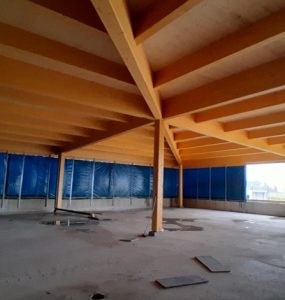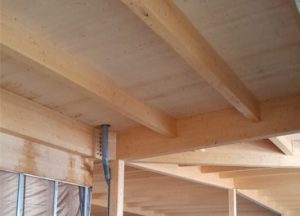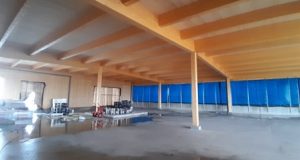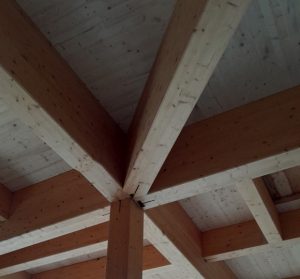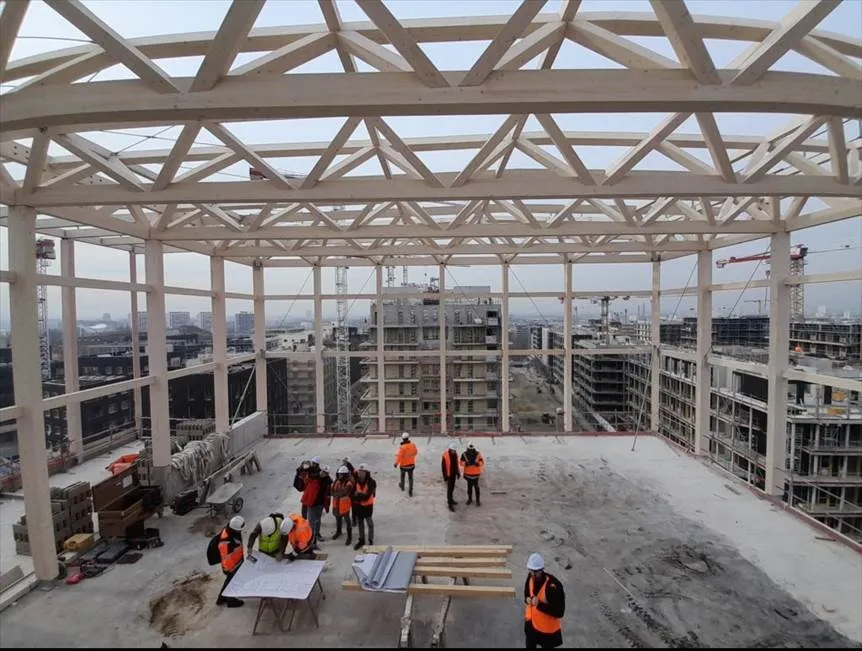setec strengthens its expertise in wood construction! This rapidly growing field represents an important lever for achieving carbon neutrality by 2050. A joint interview with Didier Sauvage, Director of Wood Construction at setec tpi, Valentina Bruno-Hure, Iari Agez and Jordi Cornudella, project engineers at setec tpi, on the strategic positioning of this activity at setec.
What are the principal responsibilities of the wood construction department?
Didier : Most of our work focuses on construction, mainly housing and facilities such as schools and gymnasiums, which account for 80% of wood construction. We work as project managers with architects on behalf of developers or as subcontractors for companies that request our services on the design stage. For example, we have built multi-storey residential buildings with 5 to 7 floors in the Olympic Athletes’ Village. We have also worked on the design of a wooden footbridge for a train station in the Alps. The more technical and diverse the projects, the more interested we are.
Why is the wood industry a strategic move for setec?
Didier : It is part of the Engineers & Citizens initiative, which has been translated into various actions, some of which concern a commitment to more environmentally friendly solutions. Wood is one such solution. There is another aspect related to regulations, RE-2020, which sets carbon emission thresholds and stipulates that they will become increasingly stringent over time. This requires the use of low-carbon solutions, which include wood due to its ability to store carbon.
Valentina : What has really made a difference in construction is the RE-2020, because environmental regulations impose thresholds that are difficult to achieve using concrete alone. Where we have an advantage is in more complex projects involving a mix of materials. We have all the necessary skills in-house: wood, concrete, metal and geotechnics with terrasol.
Jordi : setec is known for its concrete and steel projects, and we weren’t yet positioned in the wood market, even though more and more projects are incorporating wood. The demand is there, and architects are interested.
Iari : Yes, wood is booming. We see this among young people who have strong environmental convictions and don’t necessarily want to join a large organisation that only works with concrete. They see this as contradictory to their commitments.
How innovative are your projects?
Didier :
There are two aspects to innovation:
- The first concerns the study of the compatibility between the technical solutions chosen, since masonry has been the standard technique until now. Today, we are increasingly assembling different construction systems: concrete for the base, wood for the surrounding structure and upper floors. This requires technical investigations into how the materials behave when used together.
- The second concerns taking into account the specific characteristics of off-site manufacturing. Most wooden structures are prefabricated, which requires us to consider manufacturing techniques and their limitations in order to avoid designing structures that are too complex.
This is innovative in terms of research.
And if you had to think of an idea that would shake up everything that is being done today, what would it be?
Valentina : “Dismantling” with a view to reuse is the real innovation. The design of structures that can eventually be completely dismantled, allowing beams and pillars to be reused in other buildings, still needs to be developed. This would be a real advantage for wood. Today, metal rods are fixed into the wood, which cannot be removed without damaging the beam
Jordi : Another innovation would probably be the use of other types of wood. In France, spruce is used in construction, which is a softwood. However, it is not the most common type of wood; hardwood tends to be more popular. And today, many coniferous forests are dying due to global warming: temperatures are rising, insects are proliferating and destroying forests. There is beech, which has a compressive strength comparable to that of the best concrete, but it is a material that is very sensitive to water. The challenge is therefore to identify other species that could be suitable.
What are the main challenges facing this sector ?
Jordi : There is the issue of fire safety, which we are working on to integrate more wood into construction. This involves informing project owners, firefighters and architects to show them the benefits of using this material.
Valentina : Today, there is a specific set of calculations for fire modelling. By combining this with full-scale tests, the aim is to change public opinion. Fire safety standards vary depending on the type of building, the number of occupants and the height above ground level. For example, fire engines have ladders measuring 28 metres: above this height, a significant hazard factor applies.
Iari : This is also calculated in terms of fire: exposure must not exceed a certain regulatory time limit. Unlike metal, which can withstand a certain temperature before collapsing, wood does not react in the same way. The area not reached by flames retains its strength. It is possible to calculate the residual section capable of withstanding X minutes of fire. However, wood is a combustible material: the more you add, the more it feeds the fire.
We take a closer look at the career of Iari Agez, engineer in charge of concrete and metal projects, who tells us more about the switch to wood…
Why did you make this change? What attracts you to wood compared to other materials?
Iari : I realised that metal and concrete are no longer the only options today. With the environmental regulations imposed on new projects, developers are having to look to other materials. As someone who wants to continue designing buildings, I felt that I lacked the knowledge to see a project through to completion. That’s what got me interested in wood. I also lecture at schools, and the new generation is losing interest in concrete and steel. When they tackle a project, they start the design process by choosing materials such as stone, wood or even earth.
What kind of adaptation and learning did this involve?
I had to learn about wood very quickly, as I was thrown straight into working on this kind of project. On the production side, we are the last link in the chain: we provide the company with the essential elements to complete the project, so there is no room for error. Thanks to the in-house training programme and the entire Wood team, which is made up of people trained exclusively in woodworking, I have been able to successfully complete a number of projects. It’s a collective effort where we all support each other.
Why do you think wood construction is a promising sector? What explains the current trend towards eco-design?
There is a growing awareness that we need to protect the environment we live in and that resources are not inexhaustible. Wood is a renewable material and is less polluting than steel, which requires a lot of energy to produce and is therefore harmful to the environment.
